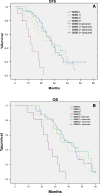Small breast epithelial mucin tumor tissue expression is associated with increased risk of recurrence and death in triple-negative breast cancer patients
- PMID: 23635316
- PMCID: PMC3680073
- DOI: 10.1186/1746-1596-8-71
Small breast epithelial mucin tumor tissue expression is associated with increased risk of recurrence and death in triple-negative breast cancer patients
Abstract
Background: Small breast epithelial mucin (SBEM) has been implicated in tumor genesis and micrometastasis in breast cancer. Triple-negative breast cancer (TNBC) was characterized by high incidence in young women,early relapse and a very poor prognosis. The aim of this study was to evaluate the association of SBEM expression in tissues of TNBC with disease-free survival (DFS) and overall survival (OS).
Methods: SBEM protein expression was detected in 87 available formalin-fixed paraffin-embedded (FFPE) tissue specimens from TNBC patients by means of immunohistochemistry (IHC). We analyzed the correlation between the SBEM protein expression and DFS and OS during a 5 year follow-up period, respectively. And a SBEM cut-off value of prognosis was established associated with DFS and OS. SBEM was analyzed against other risk factors in multivariate analysis.
Results: SBEM 3+ score was cut-off value of prognosis and significantly correlated with DFS (p = 0.000) and OS (p = 0.001) in TNBC patients. There was a marked associations (p <0.05) between SBEM 3+ score and tumor size, grade, node status, TNM stage and Ki67. Multivariate analysis showed that patients with SBEM 3+ represented a higher risk of recurrence and mortality than those with a lower SBEM expression (HR = 3.370 with p = 0.008 for DFS and HR = 4.185 with p = 0.004 for OS).
Conclusions: SBEM is an independent risk predictor and may offer utility as a prognostic marker in TNBC patients.
Figures




Similar articles
-
The expression and clinical significance of the androgen receptor and E-cadherin in triple-negative breast cancer.Med Oncol. 2012 Jun;29(2):526-33. doi: 10.1007/s12032-011-9948-2. Epub 2011 Apr 26. Med Oncol. 2012. PMID: 21519872
-
Biological Characteristics and Long-term Outcomes in Node-negative Breast Cancer.Clin Breast Cancer. 2020 Aug;20(4):e481-e489. doi: 10.1016/j.clbc.2020.02.011. Epub 2020 Mar 6. Clin Breast Cancer. 2020. PMID: 32279915
-
Outcomes of Triple-Negative Breast Cancers (TNBC) Compared with Non-TNBC: Does the Survival Vary for All Stages?World J Surg. 2016 Jun;40(6):1362-72. doi: 10.1007/s00268-016-3422-4. World J Surg. 2016. PMID: 26842691
-
Subcellular expression of MTA1, HIF1A and p53 in primary tumor predicts aggressive triple negative breast cancers: a meta-analysis based study.J Mol Histol. 2024 Jun;55(3):303-315. doi: 10.1007/s10735-024-10190-9. Epub 2024 Apr 13. J Mol Histol. 2024. PMID: 38613589
-
Cellular iron metabolism in prognosis and therapy of breast cancer.Crit Rev Oncog. 2013;18(5):435-48. doi: 10.1615/critrevoncog.2013007784. Crit Rev Oncog. 2013. PMID: 23879588 Free PMC article. Review.
Cited by
-
The Discovery of Novel Biomarkers Improves Breast Cancer Intrinsic Subtype Prediction and Reconciles the Labels in the METABRIC Data Set.PLoS One. 2015 Jul 1;10(7):e0129711. doi: 10.1371/journal.pone.0129711. eCollection 2015. PLoS One. 2015. PMID: 26132585 Free PMC article.
-
Clinicopathologic features of triple negative breast cancers: an experience from Pakistan.Diagn Pathol. 2014 Feb 28;9:43. doi: 10.1186/1746-1596-9-43. Diagn Pathol. 2014. PMID: 24581278 Free PMC article.
-
Incidence and Predictors of Recurrence among Breast Cancer Patients in Black Lion Specialized Hospital Adult Oncology Unit, Addis Ababa, Ethiopia: Retrospective Follow-up Study with Survival Analysis.J Cancer Prev. 2020 Jun 30;25(2):111-118. doi: 10.15430/JCP.2020.25.2.111. J Cancer Prev. 2020. PMID: 32647652 Free PMC article.
-
Small breast epithelial mucin promotes the invasion and metastasis of breast cancer cells via promoting epithelial‑to‑mesenchymal transition.Oncol Rep. 2020 Aug;44(2):509-518. doi: 10.3892/or.2020.7640. Epub 2020 Jun 9. Oncol Rep. 2020. PMID: 32627029 Free PMC article.
-
Cancer-associated fibroblast driven paracrine IL-6/STAT3 signaling promotes migration and dissemination in invasive lobular carcinoma.Breast Cancer Res. 2025 Jul 1;27(1):121. doi: 10.1186/s13058-025-02074-x. Breast Cancer Res. 2025. PMID: 40597443 Free PMC article.
References
-
- Perou CM, Sørlie T, Eisen MB, van de Rijn M, Jeffrey SS, Rees CA, Pollack JR, Ross DT, Johnsen H, Akslen LA, Fluge O, Pergamenschikov A, Williams C, Zhu SX, Lønning PE, Børresen-Dale AL, Brown PO, Botstein D. Molecular portraits of human breast tumors. Nature. 2000;406:747–752. doi: 10.1038/35021093. - DOI - PubMed
-
- Sørlie T, Perou CM, Tibshirani R, Aas T, Geisler S, Johnsen H, Hastie T, Eisen MB, van de Rijn M, Jeffrey SS, Thorsen T, Quist H, Matese JC, Brown PO, Botstein D, Lønning PE, Børresen-Dale AL. Gene expression patterns of breast carcinomas distinguish tumor subclasses with clinical implications. Proc Natl Acad Sci USA. 2001;98:10869–10874. doi: 10.1073/pnas.191367098. - DOI - PMC - PubMed
-
- Carey LA, Perou CM, Livasy CA, Dressler LG, Cowan D, Conway K, Karaca G, Troester MA, Tse CK, Edmiston S, Deming SL, Geradts J, Cheang MC, Nielsen TO, Moorman PG, Earp HS, Millikan RC. Race, breast cancer subtypes, and survival in the Carolina Breast Cancer Study. JAMA. 2006;295:2492–2502. doi: 10.1001/jama.295.21.2492. - DOI - PubMed
-
- Liedtke C, Mazouni C, Hess KR, André F, Tordai A, Mejia JA, Symmans WF, Gonzalez-Angulo AM, Hennessy B, Green M, Cristofanilli M, Hortobagyi GN, Pusztai L. Response to neoadjuvant therapy and long-term survival in patients with triple-negative breast cancer. J Clin Oncol. 2008;26:1275–1281. doi: 10.1200/JCO.2007.14.4147. - DOI - PubMed
-
- Millar EK, Graham PH, O'Toole SA, McNeil CM, Browne L, Morey AL, Eggleton S, Beretov J, Theocharous C, Capp A, Nasser E, Kearsley JH, Delaney G, Papadatos G, Fox C, Sutherland RL. Prediction of local recurrence, distant metastases, and death after breast conserving therapy in early-stage invasive breast cancer using a five-biomarker panel. J Clin Oncol. 2009;27:4701–4708. doi: 10.1200/JCO.2008.21.7075. - DOI - PubMed
MeSH terms
Substances
LinkOut - more resources
Full Text Sources
Other Literature Sources
Medical
Research Materials
Miscellaneous

